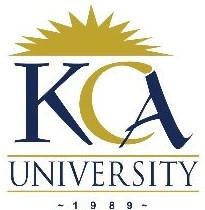 UNIVERSITY EXAMINATIONS: 2010/2011
UNIVERSITY EXAMINATIONS: 2010/2011
SECOND YEAR EXAMINATION FOR THE DEGREE OF BACHELOR OF
SCIENCE IN INFORMATION TECHNOLOGY
BIT 2205: NETWORK SYSTEM ADMINSTRATION
DATE: AUGUST 2011 TIME: 2 HOURS
INSTRUCTIONS: Answer question ONE and any other TWO questions
Question One
a) Discuss the following network elements:
i) Services (2 Marks)
ii) Devices (2 Marks)
iii) Rules (2 Marks)
b) Explain any four factors that are considered when selecting a device for a particular LAN.
(4 Marks)
c) State five types of information that an SNMP management agent might keep track of. (5 Marks)
d) (i) The KCAU corporate LAN consists of one large flat network. You decide to segment this LAN
into two separate networks with a router. What will be the affect of this change? (2 Marks)
(ii)If a host on a network has the address 172.16.45.14/30, what is the address of the subnetwork to
which this host belongs? (2 Marks)
(iii) Express the binary number 10110011 in decimal form (2 Marks)
e) State any five factors that push the demand for more bandwidth on a network. (5 Marks)
f) Explain any four benefits of creating a computer network. (4 Marks)
Question Two
a) While troubleshooting a connectivity problem on the network, you issue the ping
command from your PC command prompt, but the output shows “request times out.”
At which OSI layer is this problem associated with? Explain. (3 Marks)
b) Explain computer has been correctly configured with a static IP address, but the default gateway is
incorrectly set. Which layer of the OSI model will be first affected by this configuration error?
Explain. (2 Marks)
c) Discuss the following software troubleshooting tools:
i) NMS tools (3 Marks)
ii) Protocol Analyzers (3 Marks)
d) It is nearly impossible to troubleshoot any type of network connectivity issue without a network
diagram. In this regard, discuss how a Physical Network Diagram assists in troubleshooting a
network. (3 Marks)
e) Describe how you would go about troubleshooting network layer problems. (6 Marks)
Question Three
a) Describe the following:
i) Workgroup (2 Marks)
ii) Domain (2 Marks)
iii) Client/server network (2 Marks)
b) Explain five main functions of protocols. (5 Marks)
c) Explain briefly four of the most common network operating systems. (4 Marks)
d) When a computer boots up with the Windows installation disc, the Windows XP installation starts
with three options. Explain briefly these three options. (3 Marks)
e) List any two tools used for troubleshooting a Windows operating system problem. (2 Marks)
Question Four
a) Outline the process for physically creating a network. (7 Marks)
b) Discuss the preventive maintenance procedures for networks. (6 Marks)
c) Outline three elements that are included in a security policy. (3 Marks)
d) We use security hardware to help prevent security breaches and loss of data or equipment. In this
regard, outline four major physical security access control measures. (4 Marks)
Question Five
a) Outline the steps for correcting application layer problems (7 Marks)
b) Explain three benefits of VPNs (3 Marks)
c) Discuss the ideal operating conditions for a wiring closet (wiring closet specifications).
(8 Marks)
d) At which two layers of the OSI Model do Wide Area Networks operate in? (2 Marks)